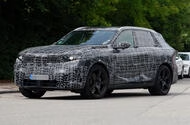BMW is making waves in the automotive world with its plans to reintroduce a range-extender (REx) drivetrain, a move aimed at enhancing the appeal of its electric SUVs. This comes at a time when charging infrastructure is still catching up in many regions, making the prospect of pure electric driving a bit daunting for potential buyers. The sixth-generation BMW X5 will be the first model to feature this innovative technology, and it’s generating quite a buzz.
Why is BMW Bringing Back the REx?
The decision to bring back the REx technology isn’t just a nostalgic nod to the past; it’s a strategic response to the evolving market landscape. BMW has seen a significant uptick in global sales of REx models, particularly in China, which is now its largest market. The REx system is designed to alleviate range anxiety by providing an electric range of over 600 miles between refueling, making it a compelling option for those hesitant about fully electric vehicles.
What Exactly is a Range-Extender?
For those unfamiliar, a range-extender works by using a small combustion engine to generate electricity, which in turn charges the vehicle’s battery. This allows for longer distances without the need for frequent charging stops. BMW first introduced this technology in 2013 with the i3 REx, but it has been absent from their lineup since the model’s retirement in 2018. Now, with advancements in technology and a growing demand for flexible electric options, the time seems ripe for a comeback.
What’s New with the Upcoming X5?
The new X5 will not only feature the REx drivetrain but will also be part of a broader strategy that includes the recently launched sixth-generation X3 and the upcoming second-generation X7, both of which are also being considered for the range-extender technology. All three models share BMW’s CLAR (Cluster Architecture) platform, which has been a staple in their design for the past decade.
Interestingly, BMW’s approach to the REx is evolving. The company is collaborating with ZF, a long-time component supplier, to develop a new range-extender architecture that promises to be more efficient and cost-effective. This new system includes two variants: eRE and eRE+, with the latter offering additional features that enhance its functionality. The aim is to run the combustion engine only within its optimal rev range, improving fuel economy and reducing emissions.
How Does This Fit into BMW’s Broader Electric Strategy?
BMW isn’t just stopping at the REx. The company is also gearing up to launch a pure-electric version of the X5 in 2026. This model will utilize the same sixth-generation electric drivetrain and cylindrical cell battery technology that will debut in the new iX3. The upcoming Neue Klasse EVs, which include the i3, iX3, and iX5, are touted to represent a significant leap in technology, featuring batteries that are denser and more efficient than current models.
The push to innovate is partly driven by competition. Chinese automaker Li Auto has made significant strides in the range-extender market, offering models that boast impressive ranges. With Li Auto’s sales surpassing 500,000 units in 2024, BMW is keen to reclaim its position in this competitive landscape.
What’s Next for BMW?
As BMW prepares to finalize the specifications for the new REx drivetrain, the anticipation is palpable. The company is navigating a fine line between innovation and practicality, especially considering CEO Oliver Zipse’s previous comments on the financial implications of combining large batteries with combustion engines. The X5 currently offers multiple drivetrain options, including petrol, diesel, plug-in hybrid, and hydrogen fuel cell, showcasing BMW’s commitment to exploring various avenues in the quest for sustainable mobility.
The big takeaway? BMW’s return to range-extender technology isn’t just about nostalgia—it’s a strategic move to adapt to market demands and consumer preferences. By focusing on flexibility and efficiency, BMW aims to provide solutions that ease the transition to electric driving. If you’re considering an electric vehicle, keep an eye on these developments; they could make a significant difference in your driving experience in the near future.

